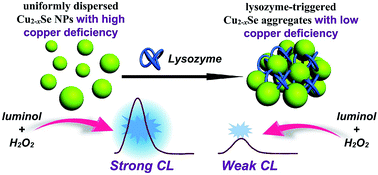A label-free turn ON–OFF chemiluminescence strategy for lysozyme detection by target-triggered Cu2−xSe aggregation†
Abstract
The sensitive and rapid quantification of lysozymes (Lys) is a critical goal in clinical practice. Herein, a novel, label-free and sensitive turn ON–OFF chemiluminescent (CL) probe for Lys was developed based on modulating the biocatalytic ability of the Cu2−xSe nanoparticles. The synthesized Cu2−xSe nanoparticles could significantly enhance the chemiluminescence signal of the luminol–H2O2 system owing to their high copper deficiency, where a very bright blue CL emission was directly observed by the naked eye in darkness and it could last for a long period of up to 36 minutes. However, Lys could induce the aggregation of the Cu2−xSe nanoparticles due to the electrostatic attraction, which could be monitored by SEM and dark-field imaging. The aggregated Cu2−xSe nanoparticles with lower copper deficiency density could suppress their catalytic ability and turn off the chemiluminescence of luminol–H2O2. The established ON–OFF CL strategy exhibited a selective response to protein Lys and showed a quantitative relationship between the changes in the CL signals and the concentration of Lys over a wide range of 0.5–5000 ng mL−1, with a low detection limit of 0.36 ng mL−1. This study provides a promising strategy for detecting biomolecules by exploiting their specific interactions with nanomaterials.



 Please wait while we load your content...
Please wait while we load your content...